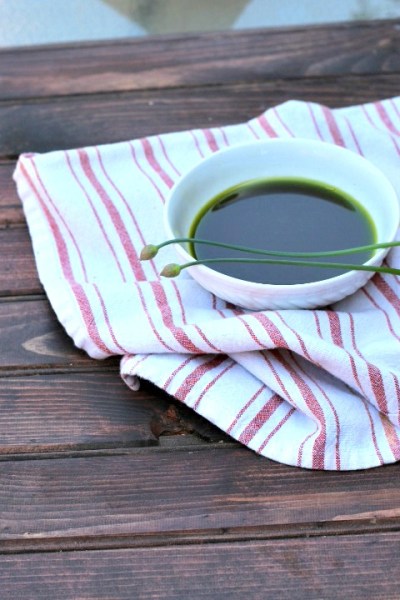
Chive Oil

My herb garden suffered some major setbacks this winter.
Because we had an usually cold winter for Oklahoma, my huge rosemary, sage and thyme bushes completely gave up the ghost and turned brown and brittle and withered away. My parsley had reached its second year and left me as well.
The only living thing showing in my herb garden this spring are some strawberry plants that strayed into it (which Mr. Wonderful won’t let me try to move).

And there are my chives.

Chives are a hardy perennial and I love it when the tops of them cap off in the spring with dainty lavender buds.

So many chefs these days are finishing their soups or main dishes with infused oils and they make a not only a beautiful presentation when served, but also add different layers of flavor to your finished dishes as well.
And the fabulous news, my friends, is that they are very simple to make. Let me show you I make chive oil.
Start out by roughly chopping up a good bunch of chives to fit in a saucepan – if you buy them, buy 3 bunches. When chopped, they should measure close to one-half a cup.
A good ratio to remember is 1 store-bought bunch of chives goes well with about ¼ cup of oil. By the time you strain a ¼ cup of oil, you don’t have much, so I figure if you’re going to dirty up your blender, why not make some to last a bit?
To make the green last in the oil extra long, you can blanch the chives first in a pot of boiling water for 15 seconds, then plunge them into an ice water bath for a minute or so, then drain them and dry them on paper towels first.

You would want to do this if you’re planning on saving much of the oil for later as it will hold its color longer.
Add them into the blender and also add in ¾ cup of olive oil. Whiz this up until the chives are completely pulverized to liquid. Your oil will turn a vibrant green.You can also add a pinch of salt if you desire but I don’t as I can always add salt to whatever dish I’m making and control it that way.

Next, pour your chive oil over a fine sieve.

You can skip this if you like but it will be a grittier texture. But if you love chives and don’t want to dump them out, you could totally keep the puree in the oil.
I let this sit on my kitchen counter for about an hour to drip through as I’ve read that pressing on it with a spoon makes it cloudy.

An hour later I dumped the solids into the trash and had this richly colored green oil. You can serve it in a bowl for drizzling or a cute bottle.
Want to be really fancy-schmancy? Get one of these squeeze bottles for pennies.

You can use them to make lovely dots and swirls on creamy soups or even stews, poached or scrambled eggs, mashed potatoes, grits or polenta, or vegetables like roasted asparagus, which is also in season right now!

The chive oil will keep in the refrigerator up to 2 weeks. The olive oil will solidify somewhat in the refrigerator but don’t worry, just leave it out to come to room temperature before you plan on using it again and it will be good as new.

Now that you know how to make chive oil, experiment with other fresh herbs and make other oils for dishes. Here are some suggestions:
Some other oils you can make:
Basil Oil: Use 1 cup chopped fresh basil.
Mint Oil: Use 1 cup chopped fresh mint
Oregano Oil: Use 1 cup chopped fresh oregano.
Thyme Oil: Use 1 cup chopped fresh thyme leaves.
Sage Oil: Use 1/2 cup chopped fresh sage.
Rosemary Oil: Use 1/2 cup chopped fresh rosemary.
Garlic Herb Oil: Add one clove garlic to any of the above for a garlic herb oil

- ¾ c. olive oil
- 1 c. chives, snipped into one inch pieces (about 3 bunches)
- Chop up chives into one-inch pieces
- Add oil first to blender
- Add in chives
- Turn blender on high and blend until chives are liquefied
- Pour into sieve and let drip through for an hour (optional: place coffee filter in strainer first)
- Store in refrigerator for up to 2 weeks
- Optional: Blanch chives in small pot of boiling water for 10 seconds then put in ice bath to stop cooking for a more intense green color. Dry on paper towels and proceed with recipe as normal.
- Some other oils you can make:
- Basil Oil: Use 1 cup chopped fresh basil.
- Mint Oil: Use 1 cup chopped fresh mint
- Oregano Oil: Use 1 cup chopped fresh oregano.
- Thyme Oil: Use 1 cup chopped fresh thyme leaves.
- Sage Oil: Use ½ cup chopped fresh sage.
- Rosemary Oil: Use ½ cup chopped fresh rosemary.
- Garlic Herb Oil: Add one clove garlic to any of the above for a garlic herb oil





2 Comments
Tulsa furnace filters goodman
July 3, 2014 at 11:14 am
Katie
July 4, 2014 at 9:02 am